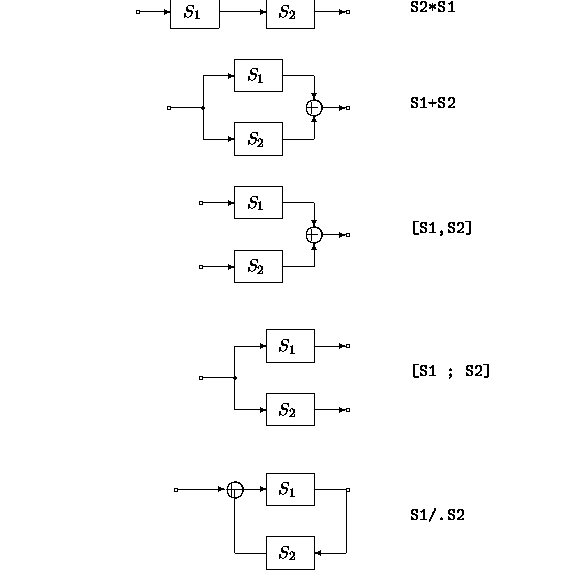 |
-->//list defining a linear system
-->A=[0 -1;1 -3];B=[0;1];C=[-1 0];
-->Sys=syslin('c',A,B,C)
Sys =
Sys(1) (state-space system:)
!lss A B C D X0 dt !
Sys(2) = A matrix =
! 0. - 1. !
! 1. - 3. !
Sys(3) = B matrix =
! 0. !
! 1. !
Sys(4) = C matrix =
! - 1. 0. !
Sys(5) = D matrix =
0.
Sys(6) = X0 (initial state) =
! 0. !
! 0. !
Sys(7) = Time domain =
c
-->//conversion from state-space form to transfer form
-->Sys('A') //The A-matrix
ans =
! 0. - 1. !
! 1. - 3. !
-->Sys('B')
ans =
! 0. !
! 1. !
-->hs=ss2tf(Sys)
hs =
1
---------
2
1 + 3s + s
-->size(hs)
ans =
! 1. 1. !
-->hs('num')
ans =
1
-->hs('den')
ans =
2
1 + 3s + s
-->typeof(hs)
ans =
rational
-->//inversion of transfer matrix
-->inv(hs)
ans =
2
1 + 3s + s
----------
1
-->//inversion of state-space form
-->inv(Sys)
ans =
ans(1) (state-space system:)
!lss A B C D X0 dt !
ans(2) = A matrix =
[]
ans(3) = B matrix =
[]
ans(4) = C matrix =
[]
ans(5) = D matrix =
2
1 + 3s + s
ans(6) = X0 (initial state) =
[]
ans(7) = Time domain =
c
-->//converting this inverse to transfer representation
-->ss2tf(ans)
ans =
2
1 + 3s + s
The list representation allows manipulating linear systems as abstract data objects. For example, the linear system can be combined with other linear systems or the transfer function representation of the linear system can be obtained as was done above using ss2tf. Note that the transfer function representation of the linear system is itself a tlist. A very useful aspect of the manipulation of systems is that a system can be handled as a data object. Linear systems can be inter-connected , their representation can easily be changed from state-space to transfer function and vice versa.
The inter-connection of linear systems can be made
as illustrated in Figure 2.1.
S1/.S2.
The representation of linear systems can be in state-space form or in transfer function form. These two representations can be interchanged by using the functions tf2ss and ss2tf which change the representations of systems from transfer function to state-space and from state-space to transfer function, respectively. An example of the creation, the change in representation, and the inter-connection of linear systems is demonstrated in the following Scilab session.
-->//system connecting
-->s=poly(0,'s');
-->S1=1/(s-1)
S1 =
1
-----
- 1 + s
-->S2=1/(s-2)
S2 =
1
-----
- 2 + s
-->S1=syslin('c',S1);
-->S2=syslin('c',S2);
-->Gls=tf2ss(S2);
-->ssprint(Gls)
.
x = | 2 |x + | 1 |u
y = | 1 |x
-->hls=Gls*S1;
-->ssprint(hls)
. | 2 1 | | 0 |
x = | 0 1 |x + | 1 |u
y = | 1 0 |x
-->ht=ss2tf(hls)
ht =
1
---------
2
2 - 3s + s
-->S2*S1
ans =
1
---------
2
2 - 3s + s
-->S1+S2
ans =
- 3 + 2s
----------
2
2 - 3s + s
-->[S1,S2]
ans =
! 1 1 !
! ----- ----- !
! - 1 + s - 2 + s !
-->[S1;S2]
ans =
! 1 !
! ----- !
! - 1 + s !
! !
! 1 !
! ----- !
! - 2 + s !
-->S1/.S2
ans =
- 2 + s
---------
2
3 - 3s + s
-->S1./(2*S2)
ans =
- 2 + s
-----
- 2 + 2s
The above session is a bit long but illustrates some very important aspects of the handling of linear systems. First, two linear systems are created in transfer function form using the function called syslin . This function was used to label the systems in this example as being continuous (as opposed to discrete). The primitive tf2ss is used to convert one of the two transfer functions to its equivalent state-space representation which is in list form (note that the function ssprint creates a more readable format for the state-space linear system). The following multiplication of the two systems yields their series inter-connection. Notice that the inter-connection of the two systems is effected even though one of the systems is in state-space form and the other is in transfer function form. The resulting inter-connection is given in state-space form. Finally, the function ss2tf is used to convert the resulting inter-connected systems to the equivalent transfer function representation.